| READY, HEAVY, GO!
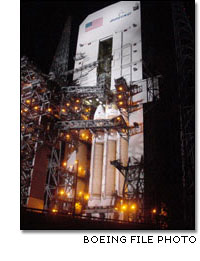 Colossal
in size, state-of-the art in technology and futuristic in manufacturing,
the Boeing Delta IV Heavy is about to rocket its first payload into orbit.
Launch is set for this fall. Colossal
in size, state-of-the art in technology and futuristic in manufacturing,
the Boeing Delta IV Heavy is about to rocket its first payload into orbit.
Launch is set for this fall.
The 235-foot-tall (72 meters) heavy lifter becomes the next entry in
the Delta family of launch vehicles, joining the dependable Delta II and
other variants of the IV. The Delta IV has a key role in the U.S. Air
Force’s Evolved Expendable Launch Vehicle program—assuring access to space
for the nation’s most critical satellite payloads.
“This mission represents a significant milestone for the nation in that
the Delta IV Heavy is the first large multi-core liquid booster launcher
in the history of the U.S. space program,” said Will Trafton, vice president
and general manager of Boeing Expendable Launch Systems. “From the development
of an all-liquid heavy-lift vehicle, to the robust RS-68 engine, the Delta
IV Heavy was designed, built and tested with all the benefits and skills
from across the Boeing enterprise and our outstanding team of suppliers
and subcontractors.”
FULL STORY >>

How do you hit a bullet
with a bullet?
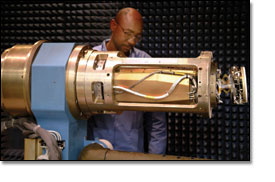 Although
the easing of tension between superpowers in the late 1980s and early
’90s reduced the likelihood of massive global conflict, a different kind
of threat exists today—the availability of sophisticated missile technology
in many smaller countries. Unfortunately, this missile technology has
proliferated and is in the hands of some who are prepared to use it. Although
the easing of tension between superpowers in the late 1980s and early
’90s reduced the likelihood of massive global conflict, a different kind
of threat exists today—the availability of sophisticated missile technology
in many smaller countries. Unfortunately, this missile technology has
proliferated and is in the hands of some who are prepared to use it.
Among the champions of missile defense is the Patriot missile system—designed
to detect, target and then destroy an incoming missile that may be no
more than 10 to 20 feet long and is typically flying at three to five
times the speed of sound. The latest version of Patriot does what scientists
once said was impossible—hit a missile with another missile, or as some
describe it: “hit a bullet with a bullet.”
FULL STORY >>

TUNNEL VISION
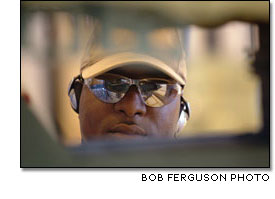 It
doesn’t take long for visitors to the T-38 modification line to discover
that even as outsiders, they’re not exactly going to be feted. It
doesn’t take long for visitors to the T-38 modification line to discover
that even as outsiders, they’re not exactly going to be feted.
Boeing people at the Williams Gateway Airport facility, just outside
Mesa, Ariz., are warm and friendly. They extend sincere greetings. Then
they quickly return to business.
“Everyone is busy,” an observer noted. “The work ethic is amazing.”
With the focus and intensity of surgeons, T-38 teammates systematically
remove and replace the aircraft’s avionics. Their actions are purposeful,
for they are members of a small team with great responsibility. Every
fighter or bomber pilot in the U.S. Air Force will train in T-38s under
their care.
FULL STORY >>

Junkyard DOGS
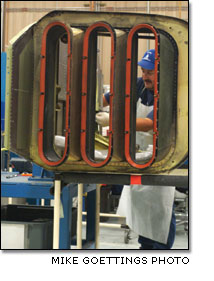 They’ve
poured sand out of parts from Apaches that patrolled the deserts of Iraq,
Kuwait, Israel and Egypt. They’ve repaired Apache components that were
plagued by bullets and mortar rounds, burned and smashed as they were
put through wars. They’ve
poured sand out of parts from Apaches that patrolled the deserts of Iraq,
Kuwait, Israel and Egypt. They’ve repaired Apache components that were
plagued by bullets and mortar rounds, burned and smashed as they were
put through wars.
They call themselves the “Junkyard Dogs.” This Stage II High Performance
Work Team has the job of transforming parts that “look like junk” into
nearly new condition for replacement on remanufactured Apache Longbows
at Boeing Integrated Defense Systems in Mesa, Ariz.
“We’re like plastic surgeons giving extreme makeovers to Apache parts,”
said Team Lead Bob Johnson. “We see how creative we can get.” In applying
that creativity, the Junkyard Dogs continue to meet the challenge of keeping
within the company’s safety and quality standards.
The 18-person team has nearly 150 years’ combined experience in repairing
composites, sheet metal and mechanical subassemblies. Some team members
have been doing the work for 20 years.
FULL STORY >>

Boeing’s strike force
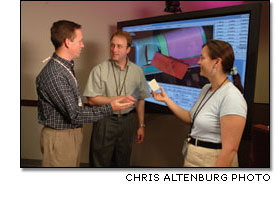 Before
retuning the Space Shuttle to flight, the Columbia Accident Investigation
Board concluded that NASA needed to develop, validate and maintain physics-based
computer models to evaluate Thermal Protection System damage to the Space
Shuttle from debris impacts. Before
retuning the Space Shuttle to flight, the Columbia Accident Investigation
Board concluded that NASA needed to develop, validate and maintain physics-based
computer models to evaluate Thermal Protection System damage to the Space
Shuttle from debris impacts.
In response, a team of Boeing employees representing Integrated Defense
Systems, Commercial Airplanes and Phantom Works began to pool efforts
to increase understanding and predict the effects of foam, ice and ablators
(insulators that act as a heat shield and help dissipate heat) striking
the orbiter.
“We are running a series of tests and performing analysis to determine
the impact of debris on the orbiter,” said Scott V. Christensen, Boeing
manager for Orbiter Vehicle Engineering and overall lead for the debris
analysis efforts.
FULL STORY >>

All the INFORMATION
wherever you
are
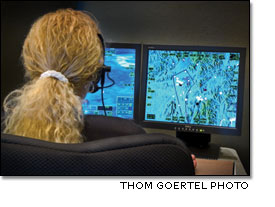 More
than two dozen reporters from major broadcast and print media outlets
gathered at three Boeing sites June 29 for a first-hand look at the power
and potential of network-centric operations. What they saw was a multiscreen,
multisite, multiplatform demonstration of the networks and tools Boeing
uses to model, simulate, and test NCO concepts, programs and solutions. More
than two dozen reporters from major broadcast and print media outlets
gathered at three Boeing sites June 29 for a first-hand look at the power
and potential of network-centric operations. What they saw was a multiscreen,
multisite, multiplatform demonstration of the networks and tools Boeing
uses to model, simulate, and test NCO concepts, programs and solutions.
The event also introduced reporters to the new Boeing Integration Center
East in Crystal City, Va.
“Boeing has invested significantly in the Integration Center, in networking
tools and the various battle laboratories we have across the country,”
IDS President and CEO Jim Albaugh said at the event, which also was broadcast
via video teleconference over the Boeing Intranet. “Using these capabilities,
we’re going to create an information-rich environment to demonstrate how
we are working with our customers to understand the power of a network-centric
approach to the battlefield.”
FULL STORY >>
|

